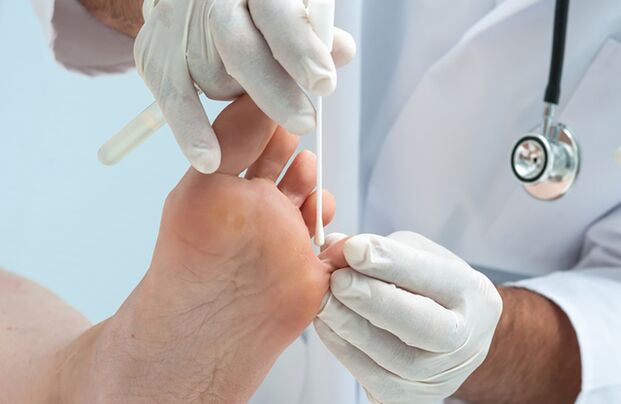
Treatment of fungal diseases should take place under the supervision of a dermatologist.Incorrectly selected antifungal agents can only lead to temporary improvement without curing the disease itself.
Treatment of fungal diseases should necessarily undergo under the supervision of a dermatologist.In case of self -medication, incorrectly selected antifungal agents can only lead to temporary improvement without curing the disease itself.
When choosing the method of therapy, it is necessary to take into account the area and form of damage, the degree of prevalence of the fungus, the presence of concomitant diseases, the patient's age.
Antifungal drugs are divided into two types: for external and internal use.The external agents themselves are effective only in the early stages of the disease, then the treatment should be complex: the fungus must be acted both outside and from the inside.
Internal drugs
For successful and safe treatment of fungal diseases, it is advisable to adhere to certain rules with internal antifungal drugs:
- The diagnosis must be confirmed by a doctor.
- For the period of treatment with internal antifungal drugs, it is advisable to limit the use of other drugs, with the exception of vital.
- Medicines should be used under the supervision of a doctor for a long time, until the fungus is completely disappeared.
- Control examinations must be carried out at first once every 2 weeks, then 1 time per month.Control scraping - 6 months after the end of treatment.When detecting the fungus, a re -treatment is necessary.
Currently, dermatologists consider pulse therapy the most effective and safe treatment method-taking a drug with long intervals.In some cases, a 1-week course of therapy is prescribed, after which follows a 3-week break and then a new seven-day course of treatment.During the intake, the drug accumulates in the body, and in subsequent weeks continues to actively fight the infection.
The full course of therapy is usually designed for three months.However, after its completion, the medicine continues to operate during the year, protecting the fungus from re -appearance.This technique, on the one hand, enables the body to “relax” from taking drugs, on the other, it does not exclude the possibility of taking other drugs, including antibiotics.In addition, the risk of relapse is significantly reduced.
External drugs
With damage to the nails, not only internal drugs are used, but also in local drugs - nail polishes and keratolytic patch and ointments to remove keratinized areas of the skin.
As antifungal varnishes, those that can penetrate into the deep layers of the nail and nail bed are used.Lacques are applied to the tops cut on top (the affected surface areas of the nail can be removed using a nail file attached to the varnish), cleaned and low -fat (for example, using alcohol) nail.
In addition, keratolytic ointments and plasters can be used to remove the affected area of the nail.These products soften the nail, as a result of which it is easily and painlessly removed from the surface of the nail bed.The patching are currently used as a keratolytic component urea or salicylic acid.Sometimes an antiseptic or local antifungal agent is added to the composition of the patch.
A keratolytic patch is applied to the surface of the nail and closed with a waterproof and bandage.After 2-3 days, the affected areas are cleaned and the patch is glued again.The procedures are performed daily until the affected nails are completely removed.The average duration of treatment is 6 months for nails on the hands and 9-12 months for nails on the legs.
In addition, special sets for the treatment of nails are produced, which usually includes an ointment that at the same time has an antifungal and keratolytic effect, a nail scraper and a patch.
For fungal skin lesions, local creams are used.The cream is applied daily to the affected areas.The average duration of treatment is 2-3 weeks;In the treatment of feet - up to 6 weeks.
Processing of infected things (disinfection)
In the process and after the treatment of fungal infection, it is very important to disinfect everything that the fungus came into contact with.Disinfection should be subjected to floors, walls, inventory of baths, showers, bathrooms, as well as the patient’s personal belongings: underwear, shoes, skin care items and nails.
The walls and bottom of the bath should be treated with a mixture of equal parts of washing powder and chlorine or chlorine diluted to the creamy consistency (the powder must be washed off after 30 minutes).You can also use a 5% solution of chloramine or chlorine lime, or a 3% lysol solution.
Shoes are recommended to be treated with formalin solutions (25%) or acetic acid (40%).It should be thoroughly wiped with a moisturized tampon insole and side sections of shoes.Then put the swab in the toe of the shoes, and put the shoes itself in a hermetically tied cellophane bag for 24 hours.After the use of acetic acid or a 25% formalin solution, the shoes are ventilated or wiped with ammonia to destroy the smell.
Lingerie, stockings, socks, tights can be disinfected by 15-20 minute boiling in a 2% soap-pond solution.Then they should be ironed with a hot iron.
Manicure scissors are disinfected, immersing in alcohol and then burning over the flame of the burner.
Prevention
To prevent infection with the fungus, it is recommended to follow the following rules:
- Use only your shoes.
- Do not wear cramped shoes in which a wet environment is preserved, and skin and nails are subjected to friction and microtrauma.
- Care for shoes, shoes after wearing should be well dried.
- It is recommended to use local antifungal agents (ointments, creams, varnishes) to people who often visit saunas, pools, baths, sports and gym halls.
- Refuse porous rugs in the bathroom - they are poorly washed and therefore serve as an excellent refuge for a variety of microorganisms, including fungi.















